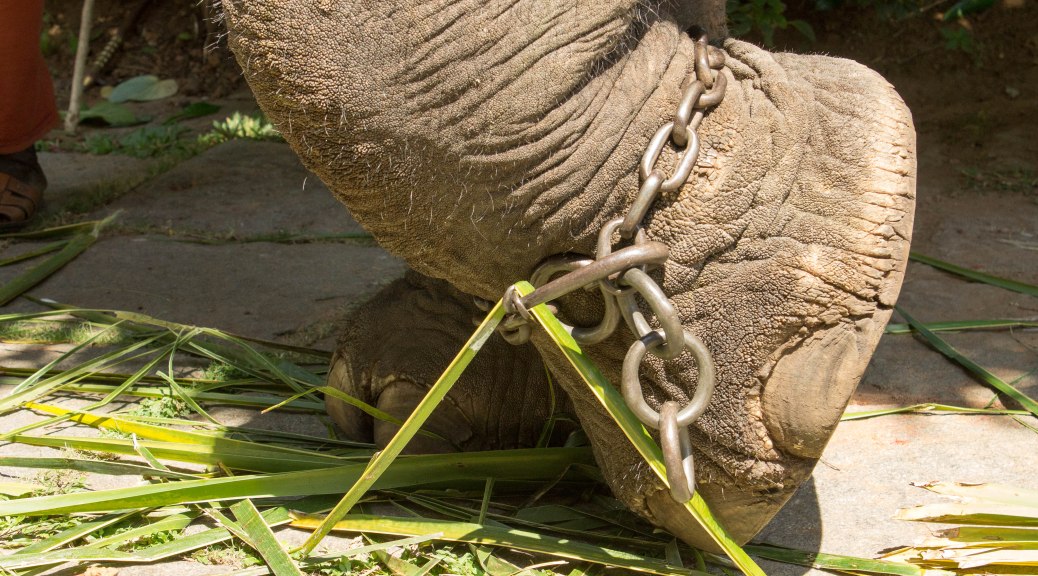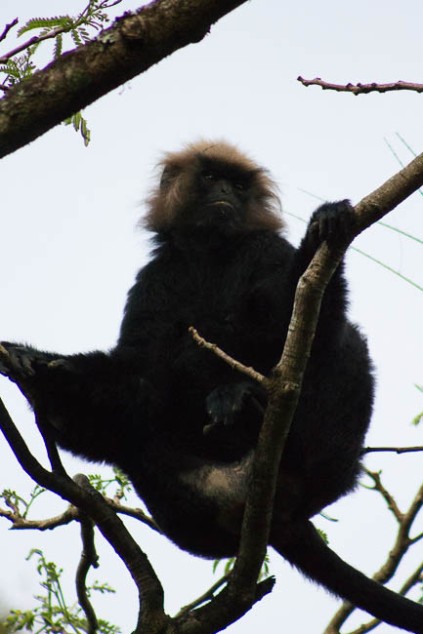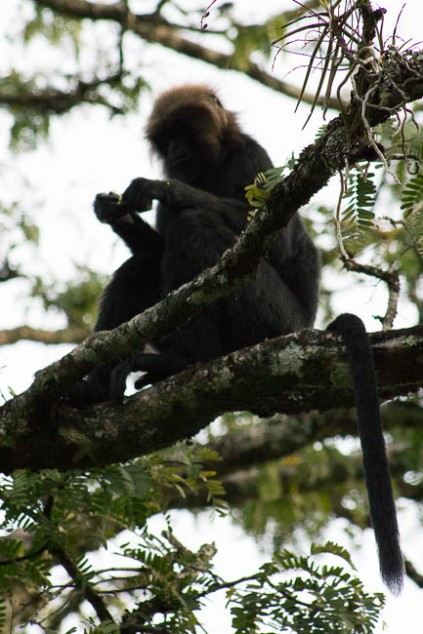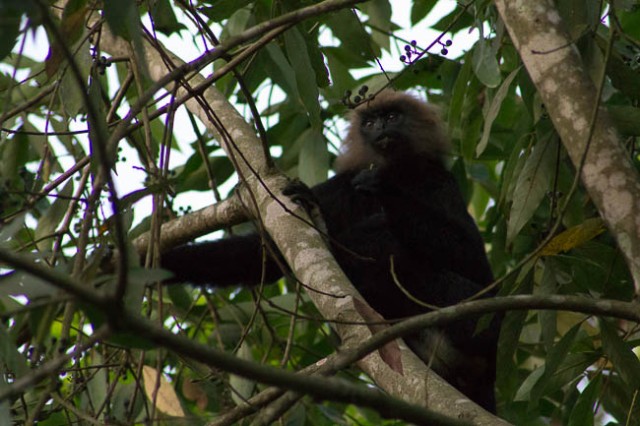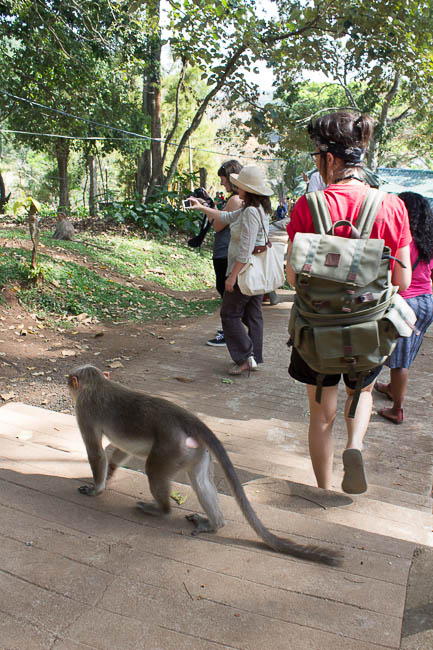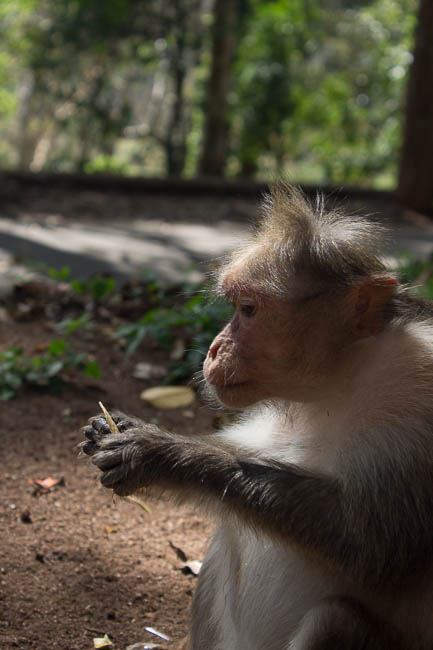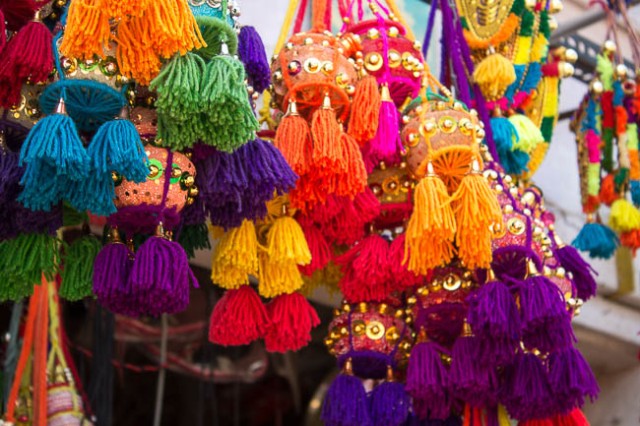
Like walking into a guide book, we ran into “domesticated” elephants several times now in Kerala, always completely by accident. Well, by accident or unknowing on our part. But the two times when we saw elephants at or near hotels were certainly no accident. I quote the word domesticated because I’m not convinced that such an animal can be domesticated. And if it can, surely this cannot happen over the course of one lifetime–isn’t true domestication a multi-generation process, a form of contrived evolution?

According to EleAid, India has some of the strictest laws in Asia governing domesticated elephants, but the laws aren’t enforced. City life is completely unsuited to what elephants need, and some elephants used in tourism or in temples are known for being chained to one spot their whole life or completely over-worked.
As a person who loves animals (and used to spend quite a bit of time with science), I find myself pulled between two poles: I want to both be with animals and see them able to live their lives naturally. As interesting as it was to spot a bear on a neighbor’s porch in Maine, for example, it was sad to realize that this animal had acquired a taste for human food and was bold enough to walk up to someone’s house and take it. This means that it is likely that bear will someday die because of something it eats or because it
 On our seventh official day of the Kerala Blog Express, we got to take a boat ride in the Periyar Tiger Reserve (*Tigers not Guaranteed.) This area is only accessible by boat, and is the first place I’ve seen in India with zero trash. The animals have substantial protected acreage at their disposal, and their lives appear to transpire without human interference, other than boats that watch from a safe distance. To me, this is how nature was meant to be observed: from a safe distance, in a respectful way, and in controlled numbers (of humans.)
On our seventh official day of the Kerala Blog Express, we got to take a boat ride in the Periyar Tiger Reserve (*Tigers not Guaranteed.) This area is only accessible by boat, and is the first place I’ve seen in India with zero trash. The animals have substantial protected acreage at their disposal, and their lives appear to transpire without human interference, other than boats that watch from a safe distance. To me, this is how nature was meant to be observed: from a safe distance, in a respectful way, and in controlled numbers (of humans.)
We were able to see elephants again in Wayanad by driving through Wayanad Wildlife Sanctuary. We were not permitted to drive through the rest of the sanctuary as planned because the weather was making the animals nervous. I was glad to hear that we were not being allowed to do something that would jeopardize our (and in turn the animals’) well-being. To me, the surest sign of a good sanctuary or preserve is that they use the word ‘no.’ There should not be a dollar amount that will assuage concerns for the animals’ well being.

As much as we love the magic and intensity (and let’s not forget the profile pics and blog posts) of witnessing a wild animal at close range, it isn’t natural. They aren’t meant to bend to our will, to eat our food, or to carry us around. They need space, not chains, and reputable research and preservation organizations need our money more than sketchy places that drug or otherwise abuse the animals do. It’s not satisfying and it won’t boost my page views, but participating in the mistreatment of animals is not what’s best for those animals. Neither is going on an elephant ride (or playing with tiger cubs), getting the cool photos, and then writing a contrite, hand-wringing post after the fact to retroactively atone for our participation. Unfortunately that seems to be the preferred route for travelers with a conscience, myself included: get the snaps, then talk about how messed up it is afterwards.

Beyond the ethics of it, animals are far more interesting when they are behaving as they choose. As fellow member of the Kerala Blog Express Daniel said on Instagram, seeing a mother and baby elephant interacting in the wild is far better than watching one perform for us on paved city streets. It was amazing to see a small herd of elephants quietly going about their business this afternoon, not bothered by our presence, not decorated by anything other than mud and their own skin, and completely free of chains.
I hope that governments and tourists alike will help make it easier for letting animals be wild to be an easy choice, one that is rewarded with good publicity and plenty of business. I hope that consumers become more aware of the power of their dollars, their presence and their photos, and wield them accordingly. I hope elephants and other, less PR-friendly animals are still around in the wild for generations to come.
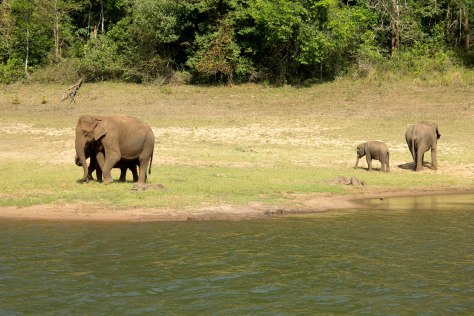
Want to learn more about how to help animals and make humane decisions? Try some of these resources below.
- 3 reputable elephant sanctuaries in Thailand (Nomadic Matt went to one of them) via Matador.
- Students in Hong Kong work to combat ivory trafficking.
- The Clinton Global Initiative’s Partnership to Save Africa’s Elephants (can we get some Asia action over here?)
- How Tourists Can Help from Humane Advisor.
- The RIGHT Tourism Getting it RIGHT list of partners.
- The Animal Friendly Tourism Guide from the World Society for the Protection of Animals.
- The Indian Government’s Project Elephant, started in 1992, lays out their plan for protection.
Disclaimer: I was in Kerala, India on a trip sponsored by Kerala Tourism. They gave no input on my posts or their subject. The views contained are completely my own. I accept advertisers as long as they are relevant to my subject matter and I experience the product, service, or location myself. For advertising inquiries, please e-mail harrington.delia@gmail.com
